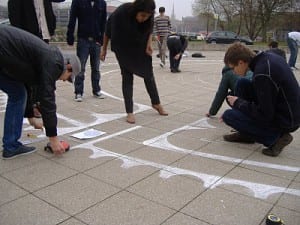Some 40 or so members of local Melton Mowbray churches attended the third session of a Lent course which was exploring different approaches to prayer. In one sense these were ‘new’ ways, but really they were all revivals of age-old traditions, largely overlooked and unused since the Age of Rationalism cast doubt on anything that wasn’t cerebral.
This 3rd session re-introduced the labyrinth, a feature of many medieval churches, particularly the cathedrals of France and northern Italy, but which fell out of use, and was only recently re-discovered in the 1990’s. By walking a labyrinth we are re-discovering a long-forgotten mystical tradition that many find surprisingly potent.
St Mary’s Church, Melton Mowbray had 20 x 20 foot space in a chapel on the south side which allowed for a 7-circuit Petit Chartres labyrinth. Using a labyrinthograph (!), the 7 circles on which this particular design is based, were traced on to the flag-stones in carpenter’s pencil which then enabled the final outline to be marked out with masking tape.
After a brief introduction, the ‘pilgrims’ were invited to walk. There was an enthusiastic but attentive response. Equally important is the reflection afterwards, in this case, shared reflection which deepened the experience and provided food for on-going meditation in the days ahead.
[nggallery id=15]
Although the outline on the floor had always intended to be short-lived –‘ for one night only’ , such was the collective experience that a decision was made to leave it in place for several more days to allow for, second walks, perhaps when fewer people were present, and for others who had not participated in the evening to have an opportunity to share in the experience.

